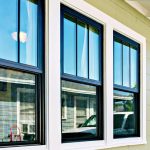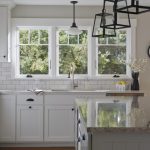Not including our “3 season room” (easterly room with only a wood stove for heating), we have a total of 13 windows. The kitchen has two picture windows, one southerly and one northerly, which we didn’t intend to work on this year, because we’re contemplating replacing them with some type of period-correct bow and garden-style window, respectively, as funding allows. However, the 11 windows on the main portion of the house we decided to tackle.The question we first had to answer was: exactly what should we do? Should we install ‘replacement windows’? Should we ‘re-hab’ the existing windows? Or how about something in-between, such as removing the old sashes and frames and installing ‘new construction’ windows (windows including the frame and all)? Another possibility was to contract the services of an outside company, like Smith Restoration Sash (google them) to manufacture replacement sashes but continue to use our existing frames. To determine our course of action, we examined the pros and cons of each option available to us.
At first, using replacement windows seemed like a really good option. However, we quickly found this was cost ineffective for us. While vinyl replacement windows are pretty inexpensive, to get “quality” replacement windows like Pella quickly runs into the $700 price range per window if you install them yourself, and over $1000 per window if you have Pella install them. Even replacement windows from Home Depot (Andersen) were no bargain — heck, the price quote from Home Depot for Andersen windows actually cost more money than windows from Pella. Frankly, I didn’t have $5000 laying around to spend on windows.
Getting a quality window was important to us, because we did not want to ruin the ‘period authenticity’ of our home. Naturally there is only so much you can do with modern construction materials to restore a 300 year old home, but we really wanted to keep it as close as we could. This is why vinyl windows were not an option, and the other replacement options from Pella/Andersen were so expensive, as we would need to have a wood interior, 3-over-2 simulated divided light windows, and aluminum-clad exterior. Sure, you can buy a vinyl replacement window for $200, but exercising this option would actually take value away from our home as we would ‘ruin’ the historic feel of the property.
‘New Construction’ windows were also eliminated as choices, due to the same constraints. Although (oddly) a new window with the same constraints containing a full frame from Pella/Andersen actually costs less money than one of their ‘replacement’ windows. Go figure, I can’t. I would think a ‘new’ window would cost more money, since you’re getting effectively the ‘replacement’ window with a full frame. Also for us to exercise this option would require us to provide ‘rough opening’ sizes, which could mean guessing and then later trying to make them fit. It would also involve removing the old trim, old frames, and potentially old cedar shingle siding to property install. This meant a lot of work we were not willing to get ourselves involved with at this time. However, we may revisit this option when we re-side the house next year.
Purchasing replacement sashes was a serious option we considered (and may do so in the future). Smith Restoration Sash can build us replacement sashes for $200 per sash ($400/window). This was also outside our price range for this project, but is also an option for the future. The window frames on the first floor are in pretty decent shape with no major sill rot, although many of them will require the trim to be replaced in the near future. Two of them could use some repair work to the exterior sill where they have deteriorated over time, but they’re still very usable.
After examining all the options, we decided that would would simply rehab our existing sashes, and get some additional life out of them. We determined we could do this for a nominal amount of money, only a few hundred dollars in paint and other materials. Then, in the future, when we are doing other work on the house (we need to re-side the home next year as many of the cedar shingles have deteriorated, and we would like to add blow-in insulation in the walls from the exterior at the same time) we can plan if funding allows to either buy
First off we had to wait until the barn was finished, since we needed space to work and tools which were at my old home in Glocester that I couldn’t bring to Rehoboth until I had a place to store them on-site. We started this project immediately upon completion of the barn. Once the barn was finished, a quick trip to Glocester with the truck and trailer to grab all the necessary tools, and we were ready to go.
We also had to squash plans to work on the 2nd floor windows. With that bastard Joe purposely breaking his ankle to get out of doing any work, Koren and I opted instead to concentrate on the 8 first floor windows. The 3 windows on the 2nd floor at the gable ends can wait until Joe is back in service and he can help.
Of the 8 first floor windows, one (the bathroom window) is a single non-removable sash window (casement-style) which we didn’t have to remove to work on. The remaining 7 windows are your typical double-hung single-pane windows with sash cords connecting to pulleys and iron weights as a counterbalance for opening and closing.
Step 01: Remove Sashes from Frame
Step 02: Prime/Repaint Old Sills and Trim
Step 02(a): Double Windows
The window frames really didn’t need a great deal of work. We applied a coat of primer (5 gallon pail from Home Depot, $55) and two coats of Behr exterior semi-gloss latex paint ($25/ea gallon) to each window. We painted the inside of the sill and the frame (which you can’t see in this picture) ‘Beluga’ –a black color — while we kept the exterior trim an off-white (total outlay $75 for 3 gallons of paint). Both of the colors we used were readily available in colonial times, so at this point we are keeping true to our desire to maintain as much ‘period authenticity’ as we possibly can. We applied a coat of primer and two coats of finish, with several days in-between for the coats to dry. In total, to paint the sills and frames took 5 hours.
Step 03: Remove all old glazing compound, glass, sand
Once the frames were complete, we could turn our attention to the individual sashes. This was, honestly, one of the most time-consuming projects we’ve ever undertaken. Each sash required a minimum of two hours of work to remove all the old glazing. Every sash had at least one (if not several) broken panes of glass. We decided we would remove every pane of glass and attempt to consolidate the removed panes into the sashes on the front of the house, since many of the panes had that ‘wavy’ texture common to old glass and we felt these would look nice in the front of the house.
To remove the glazing, we had to use a heat gun to get the old putty off. In some cases I swear the previous owners used ‘plastic wood’ rather than glazing compound to glaze the windows, the stuff was so hard. Unfortunately, heat guns have the side-effect of cracking glass, and we ended up experiencing a 50% loss rate on the glass.
Once the glass was removed, Koren used a dremel to sand out the remaining glazing compound and clean the rabbets. A dust mask was a necessity as we were sure the windows contained lead paint, and more than likely asbestos in the old glazing compound. We spent another $20 for miscellaneous supplies (sanding drums, etc.) to complete this step.
Step 04: Unglazed Windows
Once all the glazing was removed, we had to perform rehab on each individual sash. Some sashes were in good condition and required next to no rehab work. Others required more extensive rehab, including gluing and pinning of loose stiles and rails. On one window one of the rails had actually cracked and cupped along the growth rings of the wood, some wood glue, clamps, and brad nails helped cure this problem.
Using a paint scraper we cleaned off all loose paint. We used a light sandpaper to prepare the surfaces to accept some primer. Once this was complete, we applied two coats of boiled linseed oil to each frame, both interior and exterior, as a waterproofing measure. Then the sashes sat for several days to let the linseed oil “cure”. Linseed oil ran us $15 for a gallon container, and we have plenty to spare for years to come.
Step 05: Bed new glazing
Once the linseed oil cured, we started the process of reglazing the windows. This took another hour per sash. A small layer of glazing compound is required along the rabbets for the new glass panes to rest on. Although we attempted to save as many panes of glass as possible, it was necessary for us to order 50 8×12 replacement panes (single-strength window glass) at $1.89/ea.
Step 06: Replace glass and replace glazing compound
After laying a new bed of glazing compound and placing the window in the opening, we laid a “bead” of glazing compound around the outside edge of the window. Then, using a glazing tool, we “cut” the glazing back to form a nice edge. We used one large container of glazing compound per 5 sashes, at a rough cost of $7 per container, or about $21 total.
Step 07: Wash icky hands
The best way to use glazing compound is to keep a constant ball in your hand that you kneed like dough. Then it becomes soft and pliable for easily spreading along the rabbet. The side-effect though is you end up with a hand that looks like a giant yeast infection. With the oils in the glazing compound, this stuff is hard to get completely off too. We found dishwashing liquid with a degreasing ingredient worked best.
Step 08: Prime Windows
The glazing compound has to set several days before you can paint. Even then, we found that the oils in the glazing did not let primer adhere well. Next year we’re going to have to return to each window and do “touch-up” work along the edges. As you can see we didn’t much care if we overran the edges of the glass, since a little time with a razor knife once everything was reinstalled would be less time-consuming than taping off each window.
Step 09: Let dry
Global warming is our friend. For a while towards the beginning of October things got pretty cold, and it took quite a while for the paint on these sashes to fully set up. Finally, the weather broke and we were able to finish painting.
Each bottom sash we painted 4 out of the 6 sides (the bottom of the lower stile and the sides of the two rails which meet the window frame), and each top sash we painted 5 of the 6 sides (every side except the inner face). We did this in an attempt to “seal” the wood and hopefully prevent future water damage if there is any water ingress.
However, all this painting had to be done in stages, since first we had to paint the exterior, and then the sides, and in some cases (like the top sashes) it took 3 stages since you can’t paint all sides at the same time easily.
Keep in mind all this time we are sitting around the house with no windows, just plastic nailed up along the trim boards to prevent rain from getting into the house.
Step 10: Finish Coat
This was the final color of the sashes, “Beluga” as referred to by Behr (no comments about my lousy paint job, I already told ya we’re going back later with a razor knife to scrape off the glass 😛 ) We put two coats of finish on each window, the first seemed to have a lot of “bleed thru” from the primer coat underneath.
All interior-facing components of the window remained unpainted (which you’ll see in a few steps later). All exterior-facing components which see whether received two finish coats.
With 14 sashes, time to dry between each coat, etc. this entire process took us two weeks to complete.
Step 11: Buy Weather-stripping
No rehab process would be complete on windows without side type of weather-stripping. Old windows are drafty, prone to rattling in the wind, and are a huge source of heat-loss to a house.
The weather-stripping options, though, are fairly limited. The foam-rubber weather-stripping with the adhesive backing is useless for this application, since moving the window up and down within the frame would shred the weather-stripping.
There is another option available via mail order which allows you to use a router to cut a groove into the sash where you insert a felt-like strip (similar to the weather-stripping you see on aluminum windows.) At $2.50 per foot (and the fact I would need 5′ per window, I didn’t feel like spending $100 on weather-stripping.
That leaves the old felt weather-stripping stand-by. Actually, this option is an excellent choice for old wood windows. It comes in 17′ rolls that are 1.25″ thick, which is exactly the width of an old wooden sash. It is pretty thin, and does compress slightly, so it will usually “tighten up” those old windows without making them too difficult to open and close.
Some people may find they have to use a jointer to remove about a 16th of an inch of material from each window edge meeting the frame in order to get a proper fit where the window isn’t “too tight”. If the window is too tight then in the summer when the frame expands due to humidity, you may get one of more panes of glass that crack.
Unfortunately, I do not own a jointer (yet, they’re about $450) but I’m probably going to have to do this in the spring. As I’ll mentioned later in this blog entry, some of the sashes were really tight when reinstalled, and if I don’t remove some material from the edges I’ll probably get cracking in my new glass when summer arrives.
Step 12: Thumbtack as runner
Attaching the felt weather-stripping is fairly simple. You can staple it to the frame, although I do not recommend this since the staples can drag along the wooden frame, causing damage. Instead, we bought thumbtacks and placed then along the sides at regular intervals. The thumbtacks with their smooth top act as a ‘runner’ which allows the window sash to glide in the frame.
Step 13: Trim to Fit
The process of installing the weather-stripping took about 15 minutes per window. Simply attach, cut to fit, and tack in place. If I had more time I might have investigated some form of double-back sticky tape, but the thumbtack mechanism seemed to work well once it was actually implemented.
Step 14: Prepped Window
At Last! One ‘prepped’ window ready to reinstall. Only 13 more sashes to go! Yeah, it looks messy, but a little razor knife work and degreaser will clean that right up. This particular window needed an additional finish coat of Beluga paint, as you can still see the underlying primer streaks thru the paint.
Step 15: Finish coat inside window
After all the paint was dry, we started the process of reinstalling the windows. Here’s a picture of what we we living with for a month — an open window frame with only a measly sheet of plastic between us and the elements. Bbbbbbbrrrrrrrrr… it was COLD some nites too! Thank god for electric blankies!
Notice in the window frame the Beluga paint along the interior of the frame, and you can see where the off-white is on the outer portion of the frame. This window is all ready to reinstall.
Step 16: Cut new sash cord and fit to pulley
As part of the rehab process, we had to replace all of the sash cords. A 100′ roll of sash cord (real cotton sash cord) ran us $12.50. We invested for two rolls, which turned out to be perfect, since 1 roll was exactly enough to complete the 7 windows we rehabbed.
After removing the pulleys from the windows to clean them, we cut 28 equal lengths of sash cord — roughly 2.5′ each in length. Each window has four counterweights, 2 top and two bottom, which have to be installed. A knot at one end of the cord is needed to keep it from falling thru (and attaches to the sash.)
Step 17: Replace pulley
After cutting the 28 pieces of sash cord, we reinstalled each of the pulleys in the frame with the new cord. Another time-consuming process that took two hours with all the screws, needing to use a razor-knife to trim some of the paint out of the mortise in the frame, etc.
Step 18: Replace weight
The second part of the pulley installation is to replace the weight. A simple double-knot takes care of this perfectly.
Step 19: Prepare Sash cord
With the pulleys and weights back in place, we were ready to install the top sash. Reassembly of the windows is the reverse order of disassembly, so the top sash goes in first.
Along each side of a wood window is a plough and bore (which is covered here by the weatherstripping. The plough is a shallow “trench” which the sash cord sits in. The “bore” is a round hole where you insert the knot. The principle of operation is pretty simple, the knot is larger than the plough so once inserted it cannot fall “out” (or “up” in this case). Using a razor knife, slice the weather-stripping open to allow for insertion of the sash cord into the plough and bore.
Step 20: Cord both Sides
Here’s the same window with the sash-cord inserted. The weather-stripping hides the top part (and will hide the bottom portion) of the sash cord once we “dig it out” from behind the sash cord. Its hard to hold one of these in place and do this 🙂
Step 21: Tilt and place window in frame
With the sash cord in place, the sash goes back into the frame by simply tilting the window and sliding it up into place against the blind stop on the outside of the frame. With the felt-weather-stripping this can get a little tricky, since the window is now a little “thicker” than it was when we removed it.
Step 22: Completed Upper Sash
However, once the sash was resting against the blind stop, it slides up and down very nicely with no binding. Those brass thumbtacks work wonders!
Notice here the thin line of felt along the bottom of the sash. This is known as a “check rail”. The check rail is where the top and bottom sash meet, and is a common location where people forget to weather-strip. There is a fair amount of heat loss and air infiltration that takes place at this location, and by placing a piece of weather-stripping along the check rail, when the top rail of the inner sash meets the bottom rail of the outer sash, you’ll have a nice tight fit.
Step 23: Replace parting bead
Between the sashes is a thin strip of wood known as a “parting bead. This prevents the two sashes from rubbing against one another, except at the check-rail where they are designed to meet. This thin piece of wood (usually 3/8ths of an inch thick, but running the entire length of the window frame) is easy to replace and just tap into a pre-existing groove.
Step 24: Replace access panels
Also before replacing the inner sash it is necessary to put the access panels to the weight wells back into place. Its a good idea to leave them off until this step, in case you have any problems with the top sash moving and need to see inside the wells to figure out if the pulleys are working. These access panels are held in place with two wood screws flush against the frame.
Step 25: Lower Sash complete
Repeat the installation process mentioned previously for the bottom sash. Tilt in, and slide along the parting bead, slowly into place.
Step 26: Top plate
Replace the top-plate, not much else to say here. You may notice that there are no pulleys on this window — as it turned out, we had several pulleys that were broken and beyond repair. Due to the inclimate weather we opted to reinstall the windows, using all the good pulleys on the outer sashes. Once we get replacement pulleys in, we can remove the lower sash easily and put the pulleys in place.
Step 27: Inner Stops
The final step of reassembly is the inner stop, which rests along the inner side of the inside sash.
Step 28: Completed Reassembly
Voila. Completed reinstallation. This whole process takes about 45 minutes per window. We were able to reinstall all 7 windows in a little over 5 hours. Some go easier than others. We found some of the windows very tight, we will need to go back to those this spring and use a jointer to remove some material to make them fit better.
Step 29: Outside appearance
Here is the raw product on the outside. Notice the differences in the sills. We couldn’t decide if we should paint the sills to match the window color or the trim color. Thus, we decided to do one of each to see how they would look finished, with the intention of returning next year (since we have to do more painting anyway) to change the one we don’t like to the “other” color.
Which looks better, the black sill or the white sill? Email us and let us know. Personally, I like the black sill with the white trim, but Koren likes the white sill.
Step 30: Trim overpaint
When the weather warmed up a little, we went outside to use a razor knife to clean up each of the windows and prepare them for our picture storms (which is another upcoming blog entry.) This process takes about a half-hour per window, but goes fairly smoothly with some music in the background.
Step 99: Finished Product!
Voila! There you go, our finished windows. Personally, we love how the black window sashes makes the window “disappear” , in a type of shadow-box appearance. Heck, it almost looks like the windows aren’t even there — after they were not for a long time!
The total time to complete this project was astronomical. If we had to really measure the time, I would say it took us well over 200 hours of work combined over 6 weeks. There was a lot of down-time as we had to wait for paint to dry, etc.
Total cost of the project ran under $400 between the paint and all the supplies we had to buy. That’s less than the cost of one replacement window.







